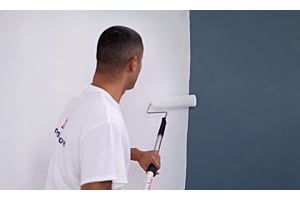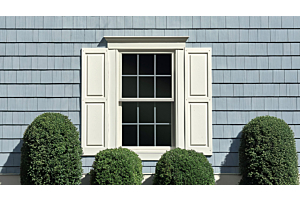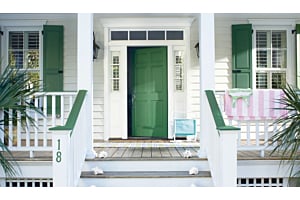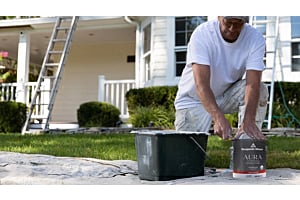
“Can I paint my vinyl?” is a question we get a lot here at Ring’s End. There’s no doubt that a fresh coat of paint makes a huge difference to a home’s exterior appeal! But like many paint projects, the answer to this question is nuanced. Yes, you can paint your vinyl siding, but there are some important considerations before you decide if you should.
In this guide, we’ll break down the pros and cons of painting vinyl—plus, we’ll share a few insider secrets on how to order vinyl paint the right way for it to last as long as possible.
The Pros of Painting Vinyl
Paint Color Options
Painting your vinyl siding offers far more color options than a manufacturer’s limited factory selection. However, not all paint colors are safe for vinyl.
The general rule for painting vinyl siding is to use only paint colors with a light reflective value (LRV) of 55 or higher — and the best practice is to avoid painting the vinyl a new color that is darker than the existing siding color. Darker colors absorb more heat and put the siding at risk of warping.
Benjamin Moore offers a selection of 75 vinyl-safe colors that are specially formulated for this purpose. These colors can be mixed into exterior house paints using a unique formula specifically designed to adhere to vinyl and withstand expansion and contraction due to temperature changes
To ensure the right formula is used, be sure to tell the paint retailer that the surface you're painting is vinyl. This step is essential—without it, the paint may not perform properly or could even damage the siding over time.
By requesting a vinyl-safe color and the vinyl formula, you'll get long-lasting results with colors that are proven to work on vinyl.
Our best-selling exterior paint is Benjamin Moore Regal Select Exterior because its acrylic formula offers a durable, long-lasting finish that maintains its color. It has excellent coverage per can, and strong adhesion on hard-to-coat surfaces like vinyl.

Best Paint for Vinyl or PVC Siding: Benjamin Moore Regal Select Exterior
Finishes: Flat, Low Lustre, Soft Gloss
Coverage per can: 300 — 400 Sq. Ft. per gallon
Dry time: 2 hours to touch, 4 hours to recoat
Vinyl Safe Colors: 75
Cost Savings
Painting vinyl siding delivers exceptional value compared to complete replacement. The cost of replacing vinyl siding includes new materials, installation labor, removal of old siding, disposal fees, and finishing work.
Painting could result in a 50-70% cost reduction—an attractive option for homeowners looking to refresh their home's exterior without breaking the budget.
Extended Lifespan for Aging Siding
Quality acrylic paint adds a protective layer that can extend your siding’s life by sealing microscopic cracks and preventing further degradation of older, brittle, or chalky vinyl. Modern exterior acrylics also contain UV inhibitors that help protect against the elements.
Technical testing shows that properly applied acrylic paint with elastomeric properties can add 7-10 years to siding that would otherwise need replacement within 3-5 years.
This extension is particularly valuable for siding manufactured before 2000, when vinyl formulations were less durable than modern versions.
Rapid Transformation Without Structural Changes
Unlike siding replacement, painting doesn't require removing existing materials, modifying trim, adjusting fixtures, or potentially uncovering structural issues behind the siding.
This approach also preserves the building envelope integrity—particularly important for homes built before contemporary house-wrap and flashing techniques became standard.
In sum, painting vinyl siding offers a wider range of color options than the color options vinyl manufacturers typically provide—especially because vinyl-safe formulas like those from Benjamin Moore are available.
It’s a cost-effective alternative to full siding replacement, saving significantly on both materials and labor. When applied correctly, quality acrylic paint can also extend the life of aging siding by sealing cracks, preventing further damage, and protecting against UV exposure—adding 7–10 years of durability, particularly for older vinyl installed before 2000.
However, painting vinyl poses some risks to the vinyl, requires maintenance, and may void siding warranty. Keep reading for more detail on considerations.
Cons of Painting Vinyl Siding
Once Vinyl is Painted, You Have to Maintain It
While your vinyl siding may be dated, faded, or dull, it's virtually maintenance-free (cleaning aside). So once you apply paint over your vinyl, it will eventually peel or blister and need touching up or recoating. Just realize that’s what you’re signing up for when you paint your vinyl!
Limitations Due to Thermal Expansion
Vinyl expands and contracts a lot with temperature changes, which can make it hard for paint to stick properly. For example, a 12-foot piece of vinyl siding can grow or shrink by as much as 5/8 of an inch between hot and cold weather.
Standard paints simply cannot accommodate this movement, leading to stress cracking, particularly at seams and overlaps. Even vinyl-specific formulations have limitations, especially in climates with rapid temperature fluctuations.
It’s best to talk with a Ring’s End paint expert about your specific location to find out how your environment may handle vinyl paint. You can text our team directly at (203) PRO-HELP.
Warranty and Longevity Concerns
Most vinyl siding manufacturers explicitly state that painting voids the product warranty—a significant consideration for relatively new installations.
Factory-colored vinyl contains color throughout the material and typically carries a 20-30 year fade-resistance warranty. By contrast, even the highest quality exterior paint has a realistic lifespan of 7-10 years before requiring maintenance coats.
If your vinyl is within its warranty period, check your manufacturer’s recommendations before painting.
Paint Color Restrictions and Heat Management
The technical limitation of using only colors with LRV (Light Reflective Value) of 55 or higher exists because darker colors can cause surface temperatures to increase by 20-50°F above ambient temperature.
At approximately 165°F, vinyl begins to soften and deform—a threshold easily reached on sunny days when using dark paint colors. Specialty vinyl-safe dark colors exist, but are not guaranteed to prevent maintenance issues and are best applied by an expert to achieve proper film thickness for heat management.
Essential Tips for Painting Vinyl Siding
If you’ve weighed the pros and cons and decided that painting your vinyl is the right path for you, consider these important tips for your project.
Wait for the Right Weather
The best time to paint vinyl is when the weather conditions are temperate (between 40°F and 80°F) and not too humid. If it’s too hot, the paint will dry too quickly; if it’s too cold or damp, it will take longer to dry and may not cure properly. Check the weather report and try to work during a dry week with mild temperatures. You’ll want to be sure there’s no rain in the forecast for at least 24 hours after the final coat of paint.
It’s especially important not to paint in direct sunlight, as vinyl siding gets very hot in direct sun. “Chase the sun” as you paint, starting with the southeastern side of the house after the sun has moved. This helps make sure the surface is dry and won’t get too hot while the paint cures.
Thoroughly Clean the Siding Before Painting
If the house siding has accumulated dirt and mildew over the years, it’s important to clean it thoroughly before trying to prime or paint. You can use a soft-bristled brush, a garden hose, or potentially a pressure washer. Keep in mind that power washing or pressure washing vinyl siding can cause damage — it’s best to only use these methods if you have prior experience and you’re confident the vinyl siding is strong enough to withstand the force.
Vinyl-safe cleaning solutions can be found at your local Ring’s End home improvement store, and many are designed to attach to a garden hose. 30 SECONDS Outdoor Cleaner or JOMAX House Cleaner and Mildew Killer are good options for cleaning stubborn mold and mildew. You can also create homemade solutions using diluted vinegar or diluted bleach. Be sure to dilute the bleach solution carefully according to the product recommendations, or it could damage the vinyl.
To get the best results from your paint job, replace any old siding slats with significant damage and repair or replace cracked, warped, or loose sections beforehand. Minor issues can often be fixed using vinyl siding repair kits available at most home improvement stores.
Once you’ve cleaned your vinyl, wait 24-48 hours to let the surface completely dry before you start painting.
Prime Before Painting
Although your paint may be self-priming, we recommend applying an acrylic bonding primer that will keep the paint from peeling or bubbling. INSL-X STIX Waterborne Bonding Primer is an excellent primer for vinyl or PVC, designed for maximum adhesion on hard-to-coat surfaces.

Best Primer for Vinyl or PVC: INSL-X STIX Waterborne Bonding Primer
Formula: Acrylic
Coverage per can: 300 – 400 Sq. Ft. per gallon
Dry time: 3 – 4 hours to recoat
Choose the Right Equipment for Your Experience Level
Vinyl siding can be painted with either a paint sprayer or paint brush and roller. The best choice for your painting project will depend on your level of experience, project budget, and personal preference.
If your house exterior has a lot of vinyl siding and you’re not experienced in using a sprayer, we strongly suggest hiring a professional exterior paint company with experience in painting vinyl.
Paint Sprayers: The advantages of a paint sprayer are its speed and ability to reach difficult spots. Using a sprayer also avoids roller marks, although you want to be careful not to overapply the paint (which would cause drips). One of the major downsides of using a paint sprayer on a house exterior is that it uses more paint than a roller (about 10% more), and overspray can damage surrounding areas.
If you go with a paint sprayer, check the paint manufacturer’s recommendations for the type of sprayer, pressure settings, and tip that will get the best results.
Paint Brush & Rollers: Working with rollers and brushes is much more labor intensive. However, rollers offer more control, paint conservation, cost less, and are easier for beginners than sprayers. Plus you don’t have to worry about overspray or the wind.
For best results, use a microfiber paint roller with a short nap (3/16” or ¼” ) for smooth surfaces or a longer nap (3/8" or 1/2") for semi-smooth surfaces that have a bit more texture. You can also use a large nylon/polyester angled paintbrush for crevices and detailed work.
Shop Vinyl Paint Products and Supplies at Ring’s End
Ring’s End is a trusted supplier of top-quality exterior paints for both professional paint contractors and homeowners tackling DIY projects. Find everything you need for a home exterior makeover in-store or online at Ring’s End, including Benjamin Moore exterior paints in vinyl-safe colors.
Ring’s End ships Benjamin Moore paint products and paint samples anywhere in the U.S. (except AK, HI, and SC) for convenient delivery to your door!
And if you have any questions about an upcoming project, don’t hesitate to contact our paint experts using our online chat or by texting (203)-PRO HELP.





